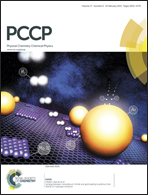Probing the mechanisms and dynamics of gas phase hydrogen–deuterium exchange reactions of sodiated polyglycines†
Abstract
The rate constants for H–D exchange reactions of sodiated polyglycines (GnNa+, n = 2–8) and polyalanines (AnNa+, n = 2, 3 and 5) with ND3 have been measured in the cell of an FT-ICR mass spectrometer. All peptides except G2Na+ are found to undergo three exchange reactions, all of which are consecutive with no sign of multiple exchanges within a single collision event. This information has been used to construct full mechanistic scenarios with the help of detailed quantum chemical calculations of the possible reaction paths for H–D exchange. The first exchange is always located at the C terminus however with different mechanisms depending upon whether the peptide termini can (larger peptides) or cannot (smaller peptides) interact directly without strong energy penalty. The most favourable mechanisms for the second and third exchanges of the N terminus protons, are found to be different from those for the first for all peptide sizes. The peptide distortions that are necessary in order for some of these reactions to occur are made possible by the energy reservoir provided by the favorable interaction of the peptide ion with ND3. Their occurrence and variety preclude any general relationship between H–D exchange kinetics and the most stable ion structures. There is however a break at G7Na+ in the kinetics trend, with a first exchange rate which is much smaller than for all other peptide sizes. This break can be directly related to a different structural type in which the C terminus is neither free nor close to the N terminus.


 Please wait while we load your content...
Please wait while we load your content...